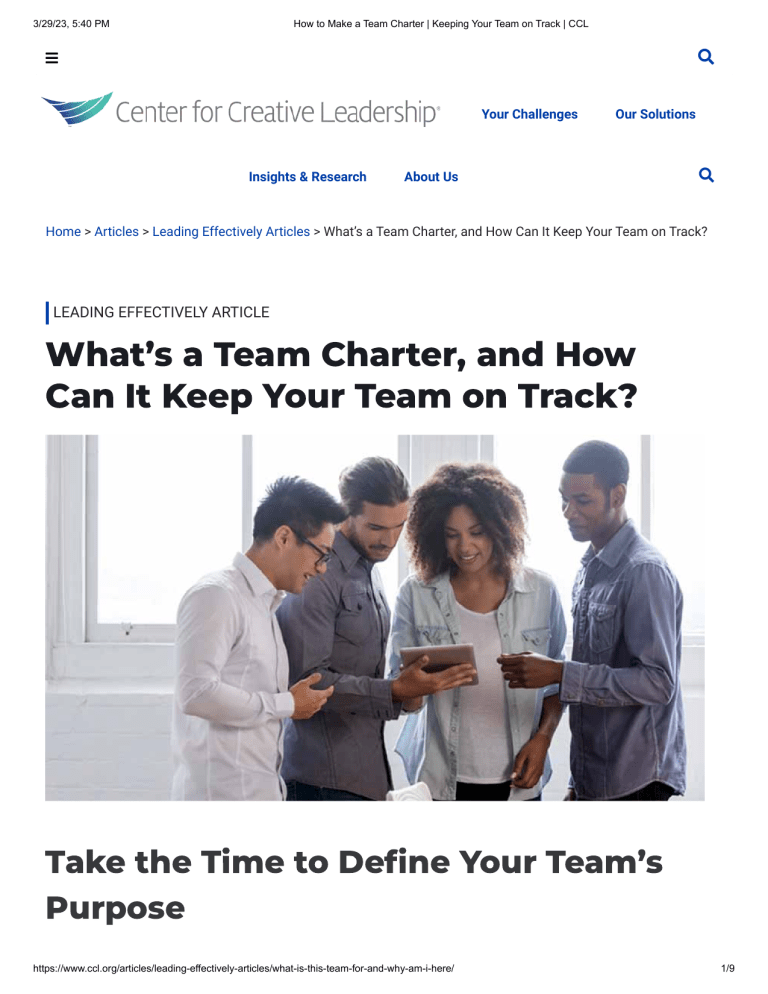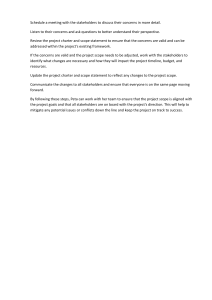54 - How to Make a Team Charter Keeping Your Team on Track CCL
advertisement

3/29/23, 5:40 PM How to Make a Team Charter | Keeping Your Team on Track | CCL View Locations Your Challenges Insights & Research Shop Contact Us Our Solutions About Us Home > Articles > Leading Effectively Articles > What’s a Team Charter, and How Can It Keep Your Team on Track? LEADING EFFECTIVELY ARTICLE What’s a Team Charter, and How Can It Keep Your Team on Track? Take the Time to Define Your Team’s Purpose https://www.ccl.org/articles/leading-effectively-articles/what-is-this-team-for-and-why-am-i-here/ 1/9 3/29/23, 5:40 PM How to Make a Team Charter | Keeping Your Team on Track | CCL Have you ever been assigned to a team only to find it was a waste of your time? Or been named “team leader” but had no idea where to start? Or found yourself on a team that’s floundering or falling apart, unable to work together? If so, it’s time to get back to basics. It may seem impractical or even silly in some work settings, but the best thing you can do is take the time to create a team charter, or a document that defines your team’s overall objectives, resources, and constraints. These roadmaps are typically created in a group setting, with team leaders facilitating discussions and walking through key questions in an effort to define several important elements like the team’s purpose, context, goals, roles, and operating methods. For teams to be successful, they need to have a basic understanding of why they exist, where they fit, and how they’ll accomplish their objectives. Here’s how to create a team charter. How to Create a Team Charter Hold a Meeting to Establish Your Team Charter Ideally, you could hold an off-site retreat for your team and set aside some time for team-building and some time to establish your team charter. (This is a technique recommended in our white paper on boundary spanning leadership practices.) To try the team charter off-site, everyone on the team should head to a place out of the office and spend half the time away doing a non-work activity together (hiking, eating, etc.), and the rest of your time constructing a team charter. At the end of the day, capture the team’s identity in a fun and memorable way. Create a short video that tells your team’s story or a touchstone that represents what the group is all about. If scheduling a team retreat is unrealistic, it’s still important to set aside a large block of time for the team to work together on creating your team charter. During your planning session, you or another team leader should walk members through key questions, visually capturing responses on a flip chart (if you’re meeting in person) or via a shared online collaboration tool (if you’re meeting virtually). Discuss These Components of a Team Charter Consider rotating the facilitation and note-taking roles as team members discuss the following components of a team charter. Work through the questions outlined below to reach agreement. Team Purpose Narrow down the group’s mission, calling, or guiding purpose into a single sentence. Agree on 3–4 values that define your group. To help determine it, ask yourselves: What kind of team is this exactly? (A work team, project team, management team, coordination team?) https://www.ccl.org/articles/leading-effectively-articles/what-is-this-team-for-and-why-am-i-here/ 2/9 3/29/23, 5:40 PM How to Make a Team Charter | Keeping Your Team on Track | CCL Why does the team exist? What’s the team responsible for accomplishing? What “work” does the team do? What topics belong “in” this team, and what’s “out”? What shared values define our group? Team Context Make sure everyone understands how the team fits into the bigger picture. Who’s the team accountable to? With what other groups/teams do we connect? What do they want/need from us? What are our differentiators? What defines and sets apart our group? What links exist between our group and others? How solid are those ties? How will our team interact with other groups? Team Goals Clarify the group’s output, tasks, or concrete contributions. Consider: What specific results do we expect from our team’s efforts? What outcomes do we want? (This may be in terms of cost, quality, speed, service, quantity, coordination, innovation, etc.) How can we measure those outcomes? Team Roles A group doesn’t exist without boundaries. Who is included on the team and who isn’t? How might this change over time? Who’s on the team? What perspective does each member bring? Are there special roles (e.g., leader, facilitator, etc.) on the team? Are there key sub-groups within the team? What do the subgroups do or require? Team Work Processes Nail down workflows and expectations. How will the team share information, deliberate, and decide things? What processes will we use to do the team’s work? (List them out, step by step.) What expectations do we have around how we work and what we do? How often will we meet? Who determines and manages our agenda? How will we connect with our stakeholders and other sponsors of our work? Team Decision-Making What decisions are made within this team? https://www.ccl.org/articles/leading-effectively-articles/what-is-this-team-for-and-why-am-i-here/ 3/9 3/29/23, 5:40 PM How to Make a Team Charter | Keeping Your Team on Track | CCL What’s out of bounds? What level of decision-making responsibility do we have? What decision process will we use? How will we communicate with each other and connect to others within the organization? (Learn some communication tools your team can try out to help people become teamwork activators, rather than blockers.) Team Norms What do we expect of each other? How do we agree to handle conflict? What are our team norms and/or operating principles? (For help, see 10 steps for establishing team norms.) Frequently Asked Questions About a Team Charter What should go into a team charter? During the initial “chartering” session, there are several important elements that should be discussed — including why the team exists; its purpose, context, roles, procedures, workflows, and norms; and how the team members will accomplish their objectives. Once all of these pieces are defined and captured, they should be translated into a shared, written document, or official team charter. How do I make a team charter? Team charters are usually created in a group setting, with the team members involved in the creation process. During the session, team leaders facilitate discussions and pose key questions that help define several critical elements about the team. This initial “chartering” discussion or brainstorm should be recorded; then, a designated team member or subgroup can work to adapt and combine your team’s agreements on the above questions into a single, formal document. Once completed, the team charter should be shared with team members and displayed in appropriate areas for future reference — such as in a shared physical workspace, as well as posted electronically for easy access. What is the goal of a team charter? The goal of a team charter, or work charter, is to define and document your team’s overall objectives, resources, and constraints. It can be a helpful tool when establishing a new team, but it can also be leveraged to re-launch or reinvigorate an existing team that’s been operating for awhile. How do I use a team charter to keep my team on track? Once the team charter has been created, you can periodically refer back to the document to help ensure your team is meeting your agreed-upon objectives. As a group, revisit it from time to time and consider the following questions: https://www.ccl.org/articles/leading-effectively-articles/what-is-this-team-for-and-why-am-i-here/ 4/9 3/29/23, 5:40 PM How to Make a Team Charter | Keeping Your Team on Track | CCL Does our work reflect our stated purpose? Have we gotten distracted, or are we staying true to our purpose? Are we meeting the needs of our team? Are we meeting stakeholders’ expectations? Are we coordinating well with others who rely on our work? Are our roles clearly defined and executed? Are we making good use of a variety of perspectives? Are our work processes effective? Are we sticking to what we agreed to in our charter? Why not? What new processes might help us be more effective? Are decisions being made efficiently and effectively? Are we including the right amount of input? What surprises or frustrations have we encountered? How might we do it differently? How well is our communication plan working? Are we sticking to it? What methods are working particularly well? What are we not doing so well? Are we living within the norms we created? Are they helping us achieve our objectives? What norms do we want to add? Delete? How can we be better in the future? As we reach our intended goals, do the measured results of our work demonstrate that? Is anything getting in the way of us being successful? Always update your team charter if team members come to an agreement about necessary modifications or new additions. That way, the team charter will continue to serve as a resource for you, your team, and your organization in the weeks, months, and years to come. Ready to Take the Next Step? Equip your team leaders with what they need to know, including how to create a team charter, so they’re able to lead co-located, hybrid, and remote teams more effectively. Partner with us for team development to foster greater team collaboration, rapport, and innovation. | What to Explore Next https://www.ccl.org/articles/leading-effectively-articles/what-is-this-team-for-and-why-am-i-here/ 5/9

